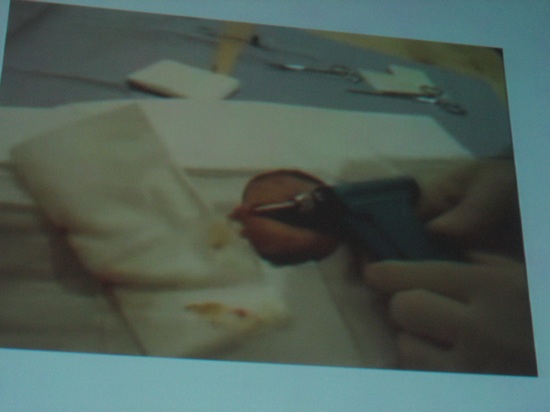

Time-Lapse Phonography
The first presenter up was Luke DuBois, a composition major from Columbia University. His time-lapse phonography presentation (http://lukedubois.com/billboard) was quite a treat. Frustrated by the massive size and inadequate navigation of the Billboard online song database, DuBois took all the number one hits from the entire Billboard Hot 100 chart since it’s inception back in 1958 and created a single 37 minute long piece of continuous sound. Each #1 song is spectrally analyzed and condensed using a software “machine” built by DuBois.
For each week a song is #1 on the chart, it receives a full second of play time. The more weeks a song is number one on the chart, the more play time it receives.
His 37 minute long audio experience showed us several things about the history of popular music. For example, the Beatles’ “All You Need is Love” spent only one week at #1 in 1967, while the big hit that year was Lu Lu’s “To Sir With Love” (5 weeks at #1). Another interesting fact that surfaced is that every number one song in 1978 is in the same key. After analysis and compression, most songs from 1958 to the late 70s sound like a single chord, but as electric drum kits and hip hop songs with electronic sound effects begin to hit number one on the chart, the songs begin to take on a chiming effect.
In 1991, the infamous Nielson company changed the way the Billboard chart calculated song ranks. Since 1998, record labels have been able to release airplay-only singles which cannot be bought in stores, but still count in Nielson’s SoundScan rating system. The result is that labels are able to manipulate release of airplay singles, formal singles, and full albums to influence the song and artist’s chart ranking. This lead to a massive shift in the amount of time a song remains number on the chart, and therefore the number of number one songs per year. In 1996 there were only 9 number one songs, while 1975 saw 35 songs hit number one. The end result is a flatter, and in my opinion, less enjoyable audioscape.
Expanding on his digital analysis skills, DuBois was able to make a visual composite of all the Playboy monthly playmates, resulting in a Barbie-esque “ideal” woman.
Sonic Fabric
Continuing with the audio theme, Alyce Santoro, creator of sonic fabric (www.sonicfabric.com), demonstrated her amazing 50% cotton, 50% audio tape creations to an already aurally stimulated dorkbot audience.
Alyce found she could take recycled 1/8th inch audio tape and place it directly into a weaving loom to create a flexible yet strong blend of tape and fiber that amazingly still holds its magnetic properties once woven.
With this sonic fabric, she has created dresses, handbags, and other clothing which all retain their magnetic audio qualities.
She was also able to actually play for us some of the fabric using a hacked up portable tape player. The audio sounds more like record scratching as the tape head is moved across it, but that’s because of the random nature the tape enters the weave of the fabric. She’s looking at possibly recording onto the fabric after it has been woven to produce recognizable audio… perhaps music or vocal recordings or just sections of fabric that produce certain tones.
DIY RFID Implants
Finishing up the meeting was Mikey Sklar’s (http://www.electric-clothing.com/chipped.html) presentation on Do-It-Yourself RFID implants.
Mikey became interested in RFID based on concerns being raised about the security and privacy issues surrounding RFID technology. His first RFID project involved replacing your pants pockets with a special fabric, essentially creating a Faraday cage for RFID access cards and credit cards one might keep in their pocket or wallet. While researching RFID security and privacy issues, Sklar came across a small but growing community of RFID implantees (http://tagged.kaos.gen.nz/). After reading about the exploits of various implant enthusiasts, Mikey decided to go under the gun and get an implant.
Mikey ordered the equipment he would need and arranged a meeting with a friend of his who was a surgeon.
The surgeon cut a small incision into Mikey’s hand to accommodate the Jecta gun’s rather large injection needle. After showing a time-lapse video of the implant procedure, Sklar demonstrated what he can do with his implant. His RFID tag ID is linked to a profile of his personal information on his Mac. By placing his hand over a Phidgets USB reader, his profile is activated.
Mikey built a custom POV (persistence of vision) display which uses his profile data to display relevant information such as new email count, headlines from news feeds Mikey is interested in, etc.
ADVERTISEMENT
















